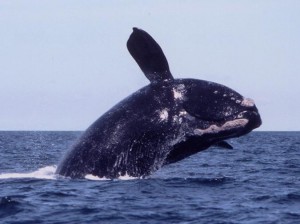An historic offshore wind energy announcement was made today that will help to protect the right whale while development occurs of an offshore wind farm known as the Deepwater ONE Offshore wind farm. The project is being developed off the coast of Rhode Island and  Massachusetts coasts, an area where the endangered right whale is frequently seen. With less than 500 right whales believed to be alive, they are highly endangered and can become confused due to underwater sounds caused by noise from the vessels doing the pre-construction site activities. The noise also impacts the right whale’s ability to communicate.
Massachusetts coasts, an area where the endangered right whale is frequently seen. With less than 500 right whales believed to be alive, they are highly endangered and can become confused due to underwater sounds caused by noise from the vessels doing the pre-construction site activities. The noise also impacts the right whale’s ability to communicate.
A coalition of leading environmental and conservation organizations — Conservation Law Foundation (CLF), Natural Resources Defense Council (NRDC) and National Wildlife Federation (NWF) — and Deepwater Wind today announced an agreement to implement additional protections that will minimize potential impacts on North Atlantic right whales and other marine mammals from underwater noise and construction vessels during the developer’s site characterization and assessment activities.
“We take our responsibility to be a national leader in responsible offshore wind development very seriously, and ensuring marine mammals are protected is just one way we’re fulfilling our commitment,” said Jeffrey Grybowski, CEO of Deepwater Wind during a press call this morning.
Deepwater Wind reached another similar agreement in the Mid-Atlantic Wind Energy areas (the area where the Cape Wind project is in development) and has committed to tailoring its business to protect marine animals in every area it develops a project.
Click here to listen to the media call:Historic Offshore Wind Right Whale Protection Agreement
Deepwater Wind in July 2013 acquired a 30-year lease to develop the Deepwater ONE project in the Rhode Island-Massachusetts Wind Energy Area, located in Rhode Island Sound, after winning the first-ever competitive lease auction for offshore wind energy development in America. The lease area covers approximately 256 square miles in the Atlantic Ocean, roughly 30 miles east of Montauk, N.Y. and roughly 17 miles south of Rhode Island, between Block Island, R.I., and Martha’s Vineyard, Mass.
“By working with CLF and our partners to protect North Atlantic right whales and other marine mammals, Deepwater Wind shows that offshore wind can achieve its potential to reduce our reliance on fossil fuels while maintaining great sensitivity to our important natural resources,” said Tricia K. Jedele, Vice President and Director of Conservation Law Foundation’s Rhode Island Advocacy Center. “We are proud to partner with Deepwater Wind, NWF and NRDC to come to this significant agreement, and hope our collective work will be replicated nationally to help bring the economic and environmental benefits of clean, renewable offshore wind power to communities throughout the U.S. without compromising vulnerable marine animals.”
The measures outlined in the agreement provide further protections for the North Atlantic right whales, including a commitment by Deepwater Wind to avoid all noise-producing activities during specific periods in the spring when North Atlantic right whales have been known to frequent Rhode Island Sound, as well as reduced speed limits for all vessels involved in site characterization and assessment activities for the Deepwater ONE project during these periods.
 This type of protection agreement is unique on the East Coast. While there are various offshore wind projects in Europe, Michael Jasny, Director, Marine Mammal Protection, Natural Resources Defense Council, noted that the species are different with the developments in Europe in areas where you find harbor porpoises and bottle nosed dolphins, and these species require very different types of conservation management.
This type of protection agreement is unique on the East Coast. While there are various offshore wind projects in Europe, Michael Jasny, Director, Marine Mammal Protection, Natural Resources Defense Council, noted that the species are different with the developments in Europe in areas where you find harbor porpoises and bottle nosed dolphins, and these species require very different types of conservation management.
“The second reason is that the government framework around offshore wind in Europe is quite different and much further along than it is in the United States,” explained Jasney. “For example, countries like Germany have very robust management programs that have been adopted.
Kit Kennedy, Director of the Energy and Transportation program at the Natural Resources Defense Council pointed out that Deepwater Wind is demonstrating that “smart from the start development” can get the offshore wind energy industry off the ground faster in the U.S.
The groups noted that offshore wind power benefits wildlife by cutting industrial carbon pollution that is leading to climate change. But the development of clean energy must provide ways to protect vulnerable species such as marine mammals.
Construction at the Deepwater ONE site could begin as early as 2017, with commercial operations by 2018. Deepwater ONE will produce enough energy to power approximately 120,000 homes annually and displace significant greenhouse gas emissions annually.

